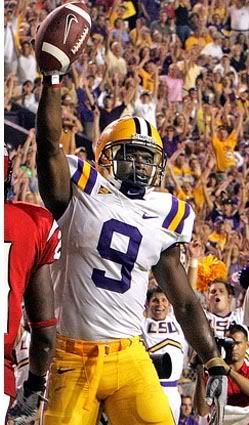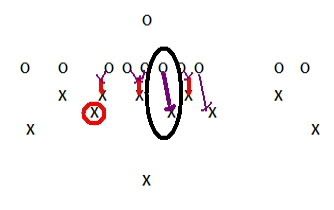 Buckeye Archive
Buckeye Archive  Analysis: The Buckeye Defense vs. The LSU Offense
Analysis: The Buckeye Defense vs. The LSU Offense
 It is really hard to predict what LSU will try to do offensively. The Tigers show a lot of different look running a wide variation of formations ranging from your typical pro set (two backs, two WRs, and TE) to four wide spread formations. While the Tigers are definitely better on the ground than in the air, they present a challenge on both fronts and from all formations.
It is really hard to predict what LSU will try to do offensively. The Tigers show a lot of different look running a wide variation of formations ranging from your typical pro set (two backs, two WRs, and TE) to four wide spread formations. While the Tigers are definitely better on the ground than in the air, they present a challenge on both fronts and from all formations.
In pro sets the Tigers like to run the ball right up the middle, but they are equally comfortable taking it off tackle on the ground. LSU has a deep backfield, but Jacob Hester is probably the best back between the tackles, he hits the hole with great power and timing, generally before the outside linebackers can rotate over. In watching film, it is pretty amazing to see how many times Hester is actually tackled by the outside backers from behind seven to ten yards down field.
This has been a critical vulnerability for the Buckeyes, as the defensive tackles have not done well in keeping offensive linemen off of James Laurinaitis. If Laurinaitis is not able to make those plays in the middle then LSU is guaranteed five to ten yards. The tackle play has improved as the season has progressed, but it is still one of the softer aspects of the defense. The Buckeyes are going to need better play or they will have to bring the strong safety up to support the run, leaving themselves vulnerable to play action pass.
Fortunately for the Buckeyes, they are very familiar with this style of running attack and LSU really does not do anything all that different than the Big Ten's power running teams. Between the tackles, LSU is eerily similar to Wisconsin. Personally, I think the Buckeyes stack up pretty well with LSU's straight-forward running game as the Buckeyes have done very well matching up against teams that run in running formations, now teams that run from passing formations with four wide receivers on the field? Not so much.
Here it is, the dreaded spread formation. Les Miles is not a complete idiot (he did after all turn down the Michigan job) so you know he is watching how teams have consistently beat Ohio State running from the spread. Normally, I do not put very much stock in previous results, particularly in college football. History is history because it is over, but the spread option run has been an issue at Ohio State for so long that it clearly is a systematic problem.
This year Ohio State inexplicably game planned against Illinois' spread offense by playing much of the game in a 3-3-5 defense. If the Illini had a competent passing attack that approach would be justified, but in the end the formation pulled Ohio State's defensive support out laterally leaving Buckeye linebackers on an island, often with a guard rearing down on them 4-5 yards downfield. 
Ohio State was caught by Illinois several times with this exact play that left James Laurinaitis isolated with an unabated guard coming down on him leading Juice Williams through A gap. In this situation the defense will rely on the weakside linebacker (circled in red) to come up and make the play a few yards down field, but it is pretty easy for the weakside backer to be screened out by all the bodies in front of him, leaving the safety as the only defense until the corners can run him down. Unless you have a Ted Washington (in his prime) style nose tackle that can line up over the center and play both A gaps, the 3-3-5 will not get the job done.
I expect to see Les Miles go to Perrilloux in the spread early to see how the Buckeyes plan to defend it. If the Buckeyes opt to go with the 3-3-5, LSU is going to run. If they don't than LSU will come out throwing. The Tigers are dangerous either way, but I would much rather see Perrilloux try to beat the Buckeyes with his arm than with his legs. LSU's starter, Matt Flynn is not a particularly accurate passer, but he will make the Buckeyes pay if he has time, so it will be essential for Vernon Gholston and Cameron Heyward to bring pressure from the outside.
LSU's left tackle, First Team All SEC selection Will Arnold, is clearly the stronger of the two LSU tackles. Right tackle Carnell Stewart was beaten often and is probably the weakest link of the LSU offensive line, so it makes a lot of sense to move your best playmaker on the line to a position where he would have a greater impact. While neither would be likely to make a lot of extraordinary plays, Cameron Heyward and Robert Rose should be able to at least keep Will Arnold interested in the game on the left side of the line.
Recently there has been a swirl of rumors surrounding the prospective return of Lawrence Wilson to the team. Wilson, who broke his leg in the first game of the year, would be essentially be burning a year of eligibility if he were to return to play in the National Championship game. While it is tempting to try to get all of your horses together for the biggest game of the year, I am not sure that it is worth burning an entire year of eligibility particularly as it appears more likely by the day that Gholston will be gone next year. Heyward has played well, and I am not sure that a rusty Wilson would do significantly better.
The Buckeyes will need to pressure Flynn and they will need to bring more than the front four, although I do expect the Buckeyes to see some success getting to the quarterback with a four man rush. Junior defensive end Vernon Gholston has proven to be equally adept at getting to the quarterback from the left or right side of the line. In the Michigan game Jim Tressel lined Gholston, normally the right end, up at left end to take advantage of Michigan's weaker right tackle. It is very possible that we could see a similar situation unfold in the LSU game.
The Buckeyes will need to vary their blitzes to keep LSU honest. It is always difficult to blitz a team that runs as many screens, shovels, and dives as LSU runs, but it will be necessary for the Buckeyes to keep the heat on the Tigers. Much has been made of the Buckeyes using Malcolm Jenkins as a safety in the nickel, but you don't hear much about the real value of it. While it is true that it is nice to have a ball-hawking playmaker out there in centerfield, the hidden value of Jenkins playing safety is that he frees up a corner to blitz because Jenkins can rotate over and pick up the corner/safeties responsibility in one-on-one coverage. Jenkins' ability to play safety gives the Buckeyes a ton of added flexibility not only in coverage, but in pass rush as well.
Ohio State's defense will set the tone for this game. How the defense handles LSU's physical play and speed will dictate the offensive game plan. If the Ohio State defense is able to consistently slow down or stop the LSU offense, then the Buckeyes offense will remain content to do what they do best, pound the ball, regardless of how successful they are at it. If the defense is unable to slow the Tigers it is pretty easy to see the Buckeyes getting away from the run and taking the ball out of Chris Wells' hands and putting it in Todd Boeckman's.
The Buckeyes should come out aggressively, even if it does bring the big play into the game. Ohio State has not given up a touchdown in excess of 40 yards since the opening play of the San Diego State game in 2005. That really is a phenomenal statistic, 34 games without allowing a team's offense to score a TD longer than 40 yards! That is impressive in that it demonstrates a very long period of defensive stability, but it is also the byproduct of a very conservative defense. Personally, I would rather see the Buckeyes bring eight to the box and force the action than sit back and react. When the Buckeyes execute an aggressive defensive game plan, the players attack the ball and fly all over the field. When the gameplan is conservative, like in Ohio State's last two losses, the defense looks slow to react and uninspired.
- NBA Announces 2013-2014 Schedule
- Browns Ink Sharknado
- Sharknado A No-Show For Rookie Camp
- Trent Richardson Out Until Training Camp
- Browns Sign Brandon Jackson
- Carrasco Suspended Eight Games
- Browns Add to Wide Receiver Depth with David Nelson
- Browns Need to Learn from Past Draft Mistakes
- Browns Release Chris Gocong and Usama Young
- Browns Missing on Grimes Disappointing, But Not The End
The TCF Forums
- Official- Browns Coach Search/Rumors
HoodooMan (Tuesday, January 21 2014 1:36 PM) - Movies coming out
rebelwithoutaclue (Tuesday, January 21 2014 12:56 PM) - 2015 Recruiting
jclvd_23 (Tuesday, January 21 2014 12:38 PM) - The 2014 Offseason Thread
Larvell Blanks (Tuesday, January 21 2014 12:25 PM) - Chris Grant's first 3 drafts
Kingpin74 (Tuesday, January 21 2014 10:13 AM) - Mike Brown
YahooFanChicago (Monday, January 20 2014 11:15 PM) - 2014 Hoops Hockey Hijinx
jpd1224 (Monday, January 20 2014 4:44 PM) - 2014 Recruiting
jclvd_23 (Monday, January 20 2014 2:26 PM) - Wish List - #4 Pick
Hikohadon (Monday, January 20 2014 1:26 PM) - #1 overall pick Anthony Bennett
TouchEmAllTime (Sunday, January 19 2014 1:28 PM)


